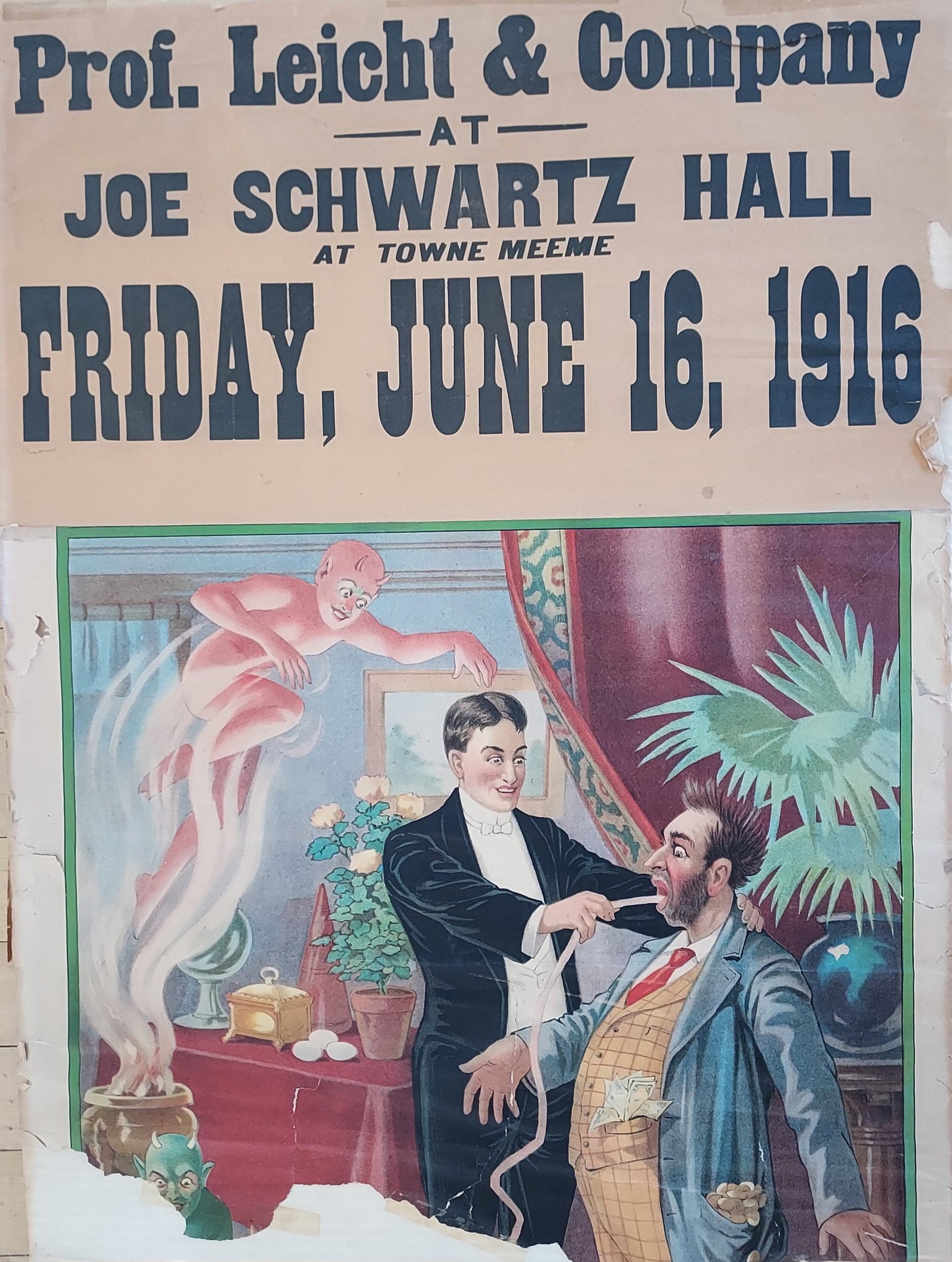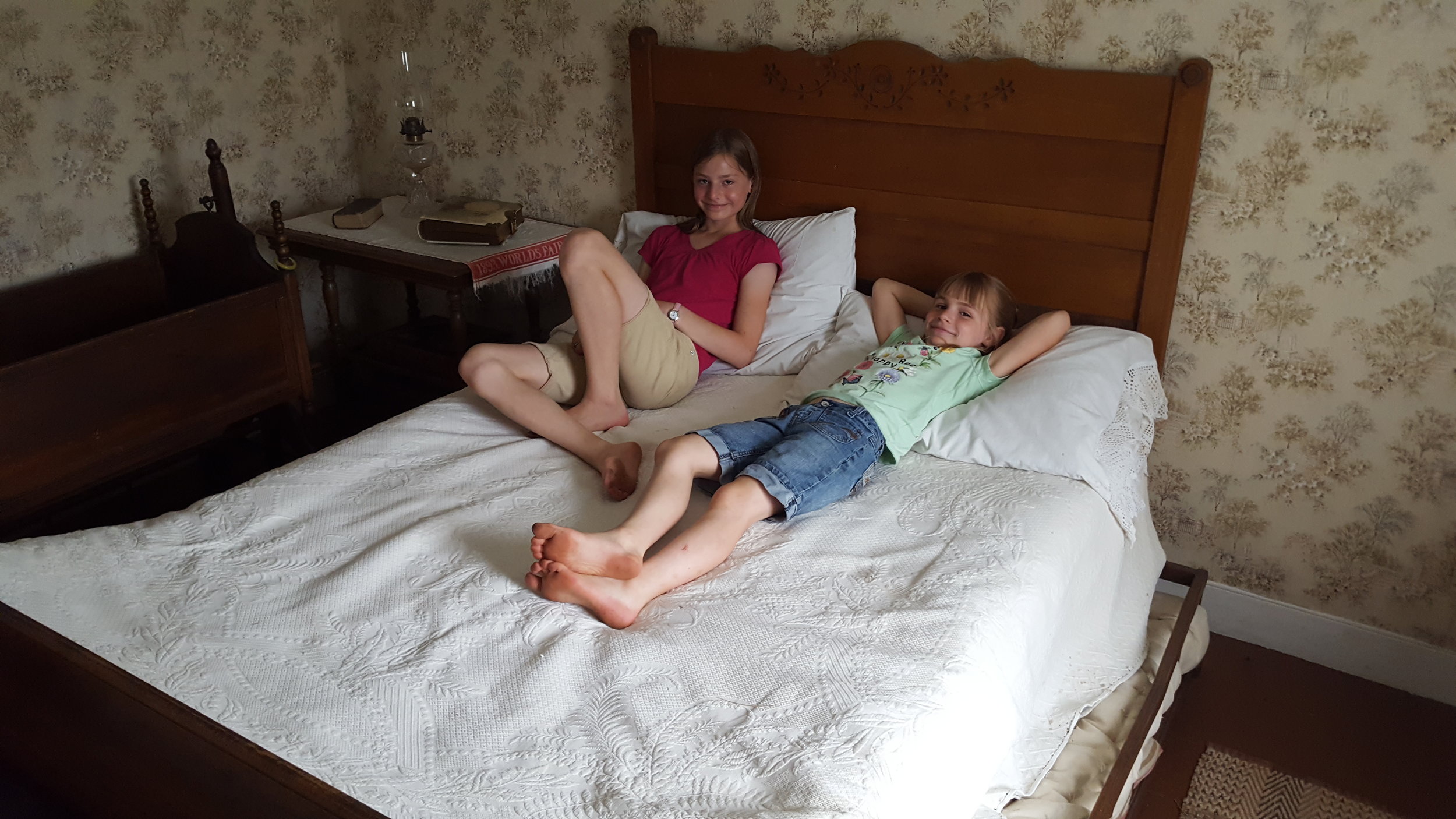Building for the Future:
The Meeme House Project
We have currently raised over $1 million towards our $1.5 million goal.
Help us raise the final $400,000 to bring the next chapter of the Meeme House to life!
The Meeme House: Yesterday and Today
Meeme House, circa 1910
The Schwartz Family on the Meeme House porch, circa 1910
Built around 1855, the Meeme House was located along the Green Bay Road. It was built by farmer and new immigrant, Michael Herr. The typical rate was around $1 a day, which included supper, lodging, breakfast and feed and stabling for a team of horses. The building had several small overnight rooms, a tavern on the first floor and a large beautiful ballroom on the second. Voting also took place inside until a new poll house was built in 1900.
It has been said that during the Civil War a rally took place in the ballroom and the next day the Civil War volunteers walked to Manitowoc to join the unit. The Meeme House was owned by the Herr family until 1906 when it was purchased by Peter DeGrott. DeGrott operated the Inn until 1909 when it was sold to Joe Schwartz. After Joe's death in 1947, his wife Minnie ran the tavern until 1955. The Meeme House Tavern was then passed on to their daughter, Valeria, and become well known as Sessler's Meeme House.
The Meeme House, and its outbuildings, will be restored to its glory in the late 1800s. The historic structure will serve as in interactive living history museum, where visitors of all ages can be transported back in time and discover the Meeme House, its livery, and poll house, in operation.
After the culmination of years of planning and fundraising, the structure will now begin its next phase of restoration.
To make this dream a reality, we need you. The Meeme House Restoration project needs your financial contributions to become a place where our history lives for today and generations to come. Together we can discover our past to dream our bright future.
Restoration Plan
The Meeme House had 2 additional wings, which were not relocated with the structure. These sections will be added with new construction. One will house a restroom area, while the other will feature a 1900s kitchen and modern day kitchen. Windows will also be installed and siding placed around the structure to ensure its weather-proofing.
Interior restoration will include the bar room, dinning rooms, post office, and boarding rooms. Interior plans for the Meeme House also include restrooms, archival storage space and an emergency storm shelter.
One of the most notable aspects of the Meeme House is the structure’s second floor. It consists of three small lodging rooms, an open ballroom, and a stage area. The Inn’s stage includes a canvas stage curtain adorned with a painting of a rural landscape. A pair of Moorish columns are present in the foreground, while a small bridge straddles a stream leading back into a mountain range. The mountain denotes the Swiss Alps in a German countryside, while painted details such as the tasseled teaser along the top of the canvas, and a butterfly curtain (popular through the 1870's and 90's) date the mural from the late 1890's to the early 1900's. Behind this cover, the stage consists of several sliding canvas panels stretched over wooden frames with painted woodland scenes.
The puppet theater and stage with 1890s hand-painted backdrops
A stage performance, circa 1915
Entertainment at the Meeme House in 1916
The Meeme House - and additional structures
Your Voice and Vote
The Town of Meeme polling house lies on the northern edge of the property and was constructed by the previous proprietor Joseph Schwartz and Edmund Kolb in 1900.
This small, gabled structure has a rectangular plan and the gabled roof line lies perpendicular to the road. Sided with wood, the structure has a front and rear entrance; the original four-paneled front door is still present. The interior has curtained booths with shelves for voters to fill in their ballots that were then deposited in locked boxes.
The Meeme Poll House is now open!
Plows and Pulleys
To the south of the Inn lies the livery barn, a 1 1/2 story, red, wooden building, whose gabled peaks lie parallel with the road. It is believed that this was the Inn's original livery stable and served to house stage teams.
The horses, cattle, and chickens played a large role in the success and livelihood for the Schwartz family and their predecessors.
The farm was comprised of 80 acres, 62 of which were improved and 18 remained wooded at the time of the 1870 Federal Census. Following is a list of all the property’s animals as they appeared in the 1870
manuscript:4 horses, 6 sheep, 5 milk cows, 6 swine,
5 other cows—Value of stock: $702.
The Meeme Livery Stable is now open!
What you can make possible
Educational overnights, enhanced programs, and historic dinners
The Meeme House will sustain its upkeep and needs with rental income and enhanced programing. Curriculum plans are developed for youth and family educational overnight experiences, as well as opportunities for formal rentals in the historic tavern and ballroom.
The addition of the Meeme House will allow for increased income:
Calling all Boarders: Imagine you came into Pinecrest Historical Village on a stagecoach. You are tired and hungry and you stop at the Meeme House for a night. This is exactly what our guests will experience during the youth educational overnight experiences offered at the Meeme House. “Guests” will register as a boarder and set up their cot for a night at the Inn. Guests will then have a snack in the dinning area and be treated to an evening entertainment program in the ballroom. Hands-on experiences will continue in the morning by making a breakfast in the circa 1900 kitchen and assisting with chores, such as gathering eggs, making a rope bed, and doing laundry.
Historic Dinners: Guests are invited to dinner at the Meeme House. Much more than a meal, you’ll step back in time to get a glimpse of life in the past and a taste of history at a Historic Dinner program! Guests can cozy up to the wood-burning stove in the dining room and pass heaping dishes of meat and potatoes around the table. These programs would be available from October to March.
Performances and rentals: Complete with first floor dining and meeting space, as well as a second story dance hall and century old stage - the possibilities are endless with what this space can become.
Discover More:
Discover the history of the Meeme House with MCHS Volunteer and Member, Charlie Bauer. Recorded in 2023.
Get a behind-the-scenes and restoration update. Recorded in 2023.
Check out this video, recorded by the Greater Centerville Historians in 2003. The video shows the Meeme House (fast forward to 15:30) and the surrounding area.
Learn the experience of some of the first guests at the Meeme House in 1852. Read our Preserving the Past blog post.











